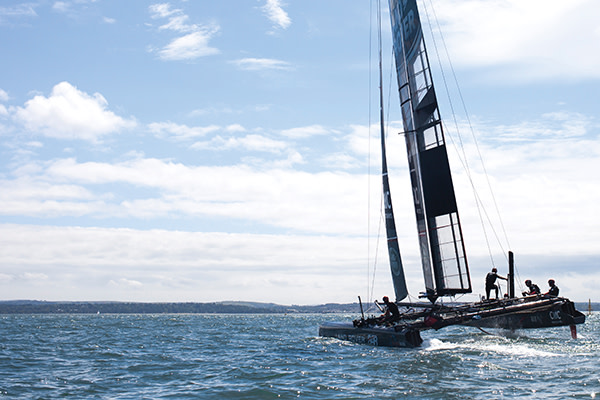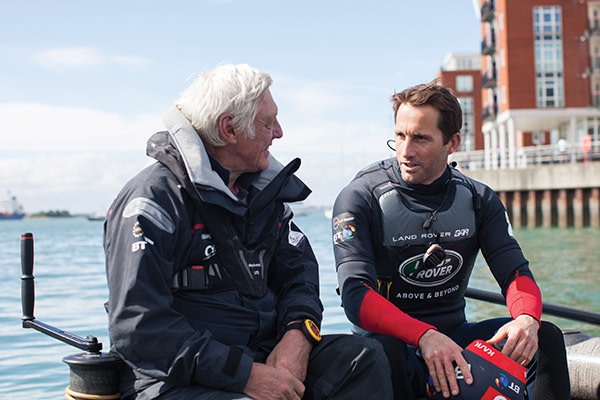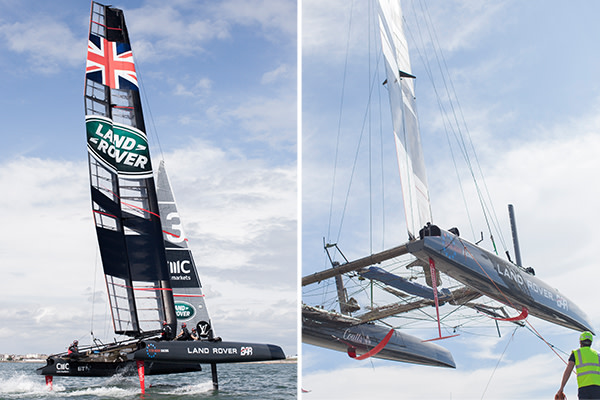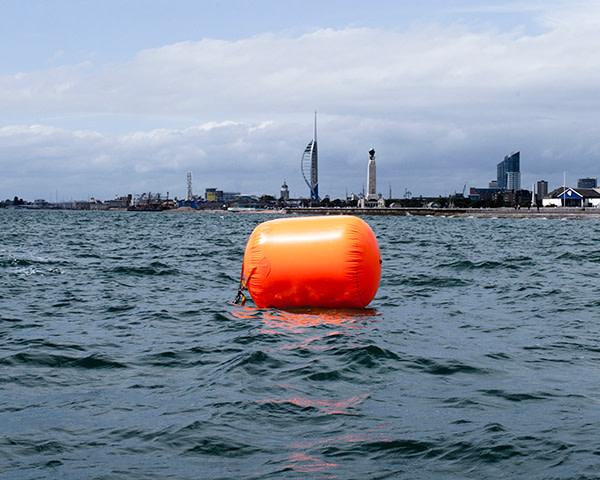Interview: Olympic sailor Sir Ben Ainslie on his new dream

Simply sign up to the Life & Arts myFT Digest -- delivered directly to your inbox.
Sir Ben Ainslie, the leader of Britain’s 2017 America’s Cup challenge, is out on the Solent, the strait between Portsmouth and the Isle of Wight. He is taking one of his test boats through her paces. The speed moves up to 15 knots, and the 1,300kg boat starts to lift on to one of her two foils, the L-shaped stilts that protrude under the hulls.
Seconds later, she is almost flying as the foil lifts her hulls out of the water. Her speed increases to 24 knots. A 17-knot gust of wind hits us, and the speed tops out at 33 knots (about 38mph). We now have only three points of contact with the water — the working foil under one of the hulls and the rudders at the back of each hull.
But the “engine” of any sailing boat is her sails — and our principal “sail” is a massive wing mast more than 70ft tall, shaped like a vertical aeroplane wing. These speed machines are called foiling wing-masted catamarans and they are to traditional sailing boats what a Formula One car is to a passenger car.
The first thing that hits me as we accelerate is the noise — the boat seems to scream as the wind howls through the rigging. The second is the stresses that these boats are under — when one of the lines holding the massive wing mast in place is released during a manoeuvre, the whole back beam shudders. “When the loads come on and off, there is a lot of what we call racking — twisting between the hulls,” Ainslie explains.
Ainslie, 39, the world’s most successful Olympic sailor, is chasing a new dream: that next year in Bermuda, he can “bring the America’s Cup back home”. Since the first race in 1851 — which was around the Isle of Wight and was won by an American yacht — Britons have challenged for the Cup 20 times but never won it. The international competition has evolved since then, and now involves a series of preliminary contests that culminate in a final race between two boats. The six postwar British attempts have ranged from disappointing to inept.
But Ainslie is a different proposition. In successive Olympic Games, he has won a silver and four gold medals, a record. Since 2000, he has been involved with three America’s Cup challenges — two American and one New Zealand. During the last challenge, in San Francisco in 2013, the Americans put him on Larry Ellison’s Oracle USA boat as tactician halfway through the series, which Oracle ultimately won.

He could have stayed with Oracle or joined another team. Instead, he decided to put together his own team, Land Rover BAR (BAR stands for Ben Ainslie Racing). They are representing Royal Yacht Squadron Racing, an affiliate of the famous Cowes Yacht Club. Ainslie’s budget is £85m, raised from sponsors and private backers. “We’ve still got a bit to go,” he says, but he expects to get there. BAR now employs more than 100 people in Portsmouth. His young sailing team spend up to 15 hours a week in intense training in BAR’s purpose-built gym, as well as four hours a day on the water. In short, this is Britain’s most serious challenge ever for the America’s Cup.
As the sun shines over the Solent, the water rippling but with no real waves, Ainslie and his team start practising gybing — a critical manoeuvre when racing as the boat alters course through 70 degrees, and the wind passes across the stern. The manoeuvre takes about 20 seconds. “Three, two, one, go board,” Ainslie calls, and he and his four crew members become a whirr of movement and athleticism. They are darting back and forth across the web trampoline that joins the two hulls, ropes are being pulled and released as the shuddering catamaran alters course, and the giant wing mast swivels from one side of the boat to the other.
“Too quick on the board,” shouts Ainslie to his crew — the “old” foil has been raised a fraction too soon, before the new one can take over, and the boat has temporarily lost her lift out of the water and therefore her speed.
At last, the timing is perfect. “Good gybe. Good work,” says Ainslie. In a good gybe, where the boat stays up on her foils, speed can be held at about 20 knots.

Next we practice a racing start. The boat hovers 50 metres from an imaginary starting line marked by two buoys and, with 10 seconds to go, starts to move. Land Rover BAR goes from three knots to more than 20 in 10 seconds, and hits the line at speed with less than a second to go.
Ainslie’s reputation on the water is fearsome — “the most competitive man on the planet”, says one of his rivals. Ainslie agrees that his on-water persona is “ruthless” and “totally focused”. Take him off a boat and he is shy and unfailingly polite. “If I behaved on land like I do when I’m racing, I would not have many friends,” he says. “I think the reason I come across as being a little bit diffident is that I have seen a lot of people who talk a good game in life and in sport. I do not want to be one of those people that talks themselves up and fails to deliver.”
Ainslie started sailing when he was seven and won his first Olympic medal when he was 19. But it has taken him 20 years to lead an America’s Cup team. He suspects it will be easier for today’s young sailors to make the transition from Olympic-level sailing to the America’s Cup challenge because of changes in boat design: “This is an era with foiling multi-hulls in the America’s Cup, and of high-performance boats and dinghies. There are more opportunities for young people than there have ever been. But to be successful, they have to be passionate about it.”
This weekend, the America’s Cup circus comes to Portsmouth as all six teams (Oracle Team USA, the holder; Emirates Team New Zealand; Sweden’s Artemis Racing; SoftBank Team Japan; Groupama Team France; and Ainslie’s) race each other in the same model of AC45 catamaran. Portsmouth is the seventh in a 10-series preliminary contest known as the Louis Vuitton America’s Cup World Series.
Ainslie and his team are just behind the leaders New Zealand and so have the chance to move to the top of the leader board. The overall series winner will carry points into the races leading up to the America’s Cup finals in Bermuda next June.
The ACWS series is a test of sailing skills and teamwork. But behind closed doors, a different battle is being fought. The six technical and design teams are working on the AC50s — 50-footers with significant opportunity for design innovation — that will compete in Bermuda next summer in the America’s Cup regatta.

Oracle Team USA, Sweden’s Artemis Racing and Emirates Team New Zealand all competed in San Francisco in 2013. “You can’t underestimate the challenge of catching them up technically,” says Ainslie. To help him, Ainslie hired Martin Whitmarsh, former boss of the Formula One McClaren team, as his CEO 15 months ago. “Within five minutes of sitting down and chatting with him, it was clear he was the perfect guy to work with.” Whitmarsh has brought in some Formula One colleagues, including Lewis Hamilton’s former chief race engineer.
The parallels with Formula One are acute. There are more than 40 people employed in BAR’s design and systems team. When Ainslie’s test boats go sailing, real-time telemetry is recording every detail of their performance.
Those foils that were lifting us out of the water cost £300,000 and take three months to build. There are rumours that the foils on Ainslie’s newest test boat — he has built four, with the Cup boat still to come — have achieved a design breakthrough. Ainslie sidesteps the question: “All the teams are working on pushing foiling as far down the wind range as possible.”
Ainslie thinks that design innovation was 75 per cent of the battle during the 2013 America’s Cup in San Francisco. This time, he thinks it will be down to 50 per cent. The other 50 per cent will be the sailing skills and teamwork on display in Portsmouth this weekend.
David Palmer is a yacht racer and a former FT deputy editor and chief executive
Photographs: Jack Latham
Comments